

The discipline of designing, organizing (curating and preparing exhibits), and directing museums is called museology.
The term "museum" harks back to the Greek origin of the institution as the abode of the muses, a place of learning and inspiration. Museums are important cultural institutions, symbols of power, stature, and sophistication. In the United States alone there are more than 1,250 art museums, half of which are less than 25 years old. Many of these are devoted to modern and contemporary art and are among the most important buildings in their communities. Once seen as elitist, these institutions enjoy broad popular appeal, diverse audiences and a substantial amount of private as well as public support. Museums are seen to be educational instruments for the systematic organization and presentation of artistic and natural phenomena. Museums are really the creation of the 18th century period known as the Enlightenment. The museum stands in contrast to the Kunstkabinette and Kunstkammer, or cabinet and chamber of curiosities, of the Renaissance, where odd and wondrous rarities were brought together for private contemplation and pleasure. Although the museum's role is more educational, looking at art in either the Kunstkammer or the museum remains both a sensory as well as a pedagogical activity.
Today's art museums range in size and type from large, publicly financed institutions, like the Metropolitan Museum of Art, to small, privately supported rural ones like the Aldrich Museum of Contemporary Art in Ridgefield, CN. Some, like Boston's Museum of Fine Arts, have encyclopedic collections; others, like the Asian Art Museum of San Francisco, have highly specialized ones. Along with the monies they raise through entrance fees, museums are supported by a broad range of activities from elaborate fundraising programs, to running or managing restaurants, gift and book shops, and publishing brochures and catalogues. Their collections grow by a number of means, chief among which are through gifts from donors and from purchases.
Museums operate under the leadership
of a board of trustees, who oversee the activities of a director,
a person who in turn supervises the work of curators,
preparators, registrars,
librarians, security guards, and others. Museums also rely upon
the labors of volunteers, many of whom act as docents,
receptionists, and clerks.
Here is a list of selected museums (click here for much longer lists):
Here are some images of museums, and related subjects:
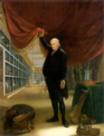
Charles Willson Peale (American, 1741-1827),
The
Artist in His Museum, 1822, oil
on canvas, 103 2/4 x 79
7/8 inches, Museum of American Art of the Pennsylvania Academy
of the Fine
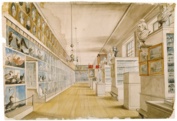 Arts.
Peale's was the first museum in the United States, a curious
mixture of fine arts and
natural history.
Arts.
Peale's was the first museum in the United States, a curious
mixture of fine arts and
natural history.
Peale's The Long Room, Interior of the Front Room in
Peale's Museum, 1822.

The Orsay Museum (Musée d'Orsay) was
originally built as the Gare d'Orsay — a railway station — in 1900. In 1986 it reopened as the French nation's museum of
late nineteenth century art. The choice of this building to house
the collection seemed inevitable, because of its location right
across the Seine from the Louvre, and because it was originally
conceived as a cathedral for the worship of all that was modern.
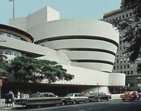
Frank Lloyd Wright (American, 1867-1959),
Solomon
R. Guggenheim Museum.

Standing beside a model of the museum, to the
right of the architect and Mrs. Guggenheim, Solomon R. Guggenheim,
a patron of the arts, commissioned this project in 1943,
and approved the plans before his death in 1949. Construction
began in 1957, and was completed in 1959. A branch of the museum
opened in Bilbao, Spain in 1997, in a building designed by Frank
Gehry — a design which is proving to be just as important as
Wright's.

The quarter-mile interior ramp, although
unbroken in its circular descent, is honeycombed with 74 bay
areas used for display purposes. This is a view from the ramp across the atrium
to the exhibition spaces on the other side of the building.

The ramp surrounding the atrium rises from the
ground to a dome 95 feet above. See architecture, dome,
and another page about the building's design.

Richard Rogers (Italian, 1933-) and Renzo
Piano (Italian, 1937-), Pompidou Center (Centre Pompidou), 1972-1976,
high-tech steel
and glass museum, with a passive
cast exoskeleton, and
a staircase in a transparent
tube.
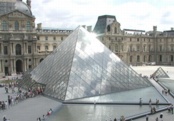
Ieoh Ming Pei (American, 1917-), Louvre Museum's expansion which was mostly underground:
the glazed pyramid entry, contains a spiral staircase below
it, 1983, Paris.
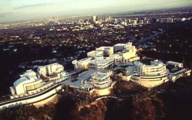
Richard Meier (American, 1934-) and Michael
Palladino (American, contemporary), J. Paul Getty Center
includes the J.
Paul Getty Museum, Los Angeles, opened to the public
in 1997. This
is an
aerial view of the Getty Center — one of the largest privately
funded architectural complexes ever designed and constructed
in a single architectural campaign. See Charles S. Rhyne's excellent
photographic survey of exterior views of the buildings.
An adjacent, though separately designed and commissioned element
of the center is Robert Irwin's (American, 1928-) Central
Garden. See aerial view.

Frank O. Gehry (American, 1929-), Guggenheim
Bilbao Museum, 1997, Bilboa, Spain. "The Guggenheim
Museum Bilbao is a collection of interconnected blocks housing
galleries, an auditorium, a restaurant, a museum store and administrative
offices. These buildings have as their central focus a single
architectural composition. With its towering roof, which is reminiscent
of a metallic flower, the museum will enliven the riverfront
and serve as a spectacular gateway to the city."
Also see accession, advocacy, architecture, art careers, arts center, catalogue, collection, deaccession, docent, donation, gallery, International Council of Museums (ICOM), Kunstkabinette, Kunstkammer, new media, theater, UNESCO Convention on the Means of Prohibiting and Preventing the Illicit Import, Export and Transfer of Ownership of Cultural Property, UNIDROIT Convention on Stolen or Illegally Exported Cultural Objects, Wunderkabinette, and Wunderkammern.
https://inform.quest/_art